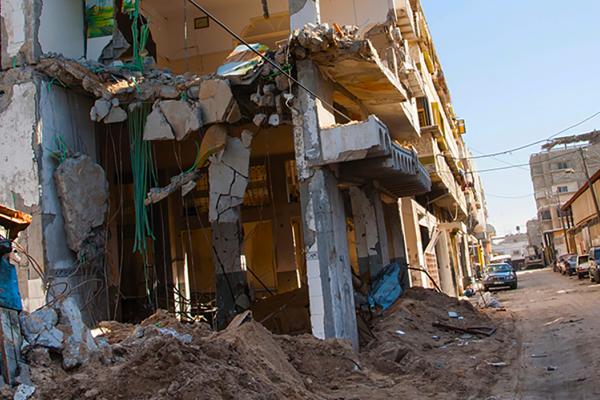MOST CHRISTIANS KNOW about Gaza from its mention in the Hebrew scriptures in the sensuous and heroic stories of Samson, corrupted by Delilah, who lured him into showing the secret of his strength (Judges 16:5). Historically a Canaanite city and then Philistine, Gaza was conquered by Joshua as a part of his conquest of the Promised Land (Joshua 10:41). For thousands of years Gaza has had a history of being destroyed and rebuilt, from the time of Alexander the Great until today.
The Gaza Strip is now a small territory to the southwest of Israel, bordered on the west by the Mediterranean Sea, with 1.8 million people living in only 140 square miles. During my visit there earlier this year, I was overwhelmed by the place’s incredible beauty; at the same time, the lack of functional sewage treatment plants, limited electricity, and other broken infrastructure result in Gazans experiencing a severe humanitarian crisis. Beautiful and tragic.
In 1967, the Israeli military seized Gaza and remained there until 2005, when Israel unilaterally pulled out under Ariel Sharon’s “disengagement” plan. Between August and September 2005, roughly 9,000 Israeli settlers were evacuated and 21 settlements destroyed (rather than turned over to Gazans). In 2007, after Hamas took control of Gaza, Israel intensified the restriction of movement and imposed land, sea, and air blockades on the territory. The blockades have led to severe living conditions for the people there and a growing humanitarian crisis.
In the past decade, the people of Gaza have experienced three wars—in 2008, 2012, and 2014—between militant groups in Gaza, including Hamas, and the Israeli Defense Forces. Children in Gaza pay the greatest price, with these explosions of violence leading to post-traumatic stress, limited access to basic humanitarian needs such as potable water and electricity, and unstable civic infrastructure.
A severe humanitarian crisis
The violence surrounding Gaza did not end with the 2014 war; even in my brief, two-day visit, I experienced the ground shaking in Khan Yunis, a southern city in Gaza. My hosts assured me that we were safe, because the bombing was several miles away, over the Egyptian border. They said the Egyptian military was bombing ISIS targets in the Sinai.
That evening, I woke from a deep sleep when I heard what sounded like a bomb go off in the distance. Immediately I received a text message from my hosts telling me that the bomb-like sound was simply a “sonic boom” caused by an Israeli military jet breaking the sound barrier. For Gazans, the fly-bys happen much less frequently than in past years, yet the volume of the shock waves reminds men, women, and children that war is always on the horizon.
In addition to these traumatizing realities, years of socioeconomic decline, conflict, and blockades have contributed to the severe humanitarian crisis Gazans face. Electricity, water supply, health, and communications are just a few of the areas in which Gazans’ daily lives have been affected.
Israeli attacks in 2014 significantly damaged the main power plant in Gaza. Access to consistent electricity, already limited, was worsened by a financial conflict between Hamas and the Palestinian Authority, which led to difficulty in purchasing diesel fuel. The only remaining reservoir has a mere three-day supply of fuel, according to the Israeli human rights organization GISHA; as a result, Gazans at times have little or no electricity for up to 21 hours a day.
Bill Corcoran, CEO and president of American Near East Refugee Aid (ANERA), explains that fuel shortage is one of the key issues affecting Gazans. Access to electricity is never dependable—it could come on at two in the morning or two in the afternoon, and each time there is no guarantee how long it will last. The inconsistencies disrupt normal life, forcing families to wake up and try to fit in everything that needs to be done before the electricity goes out. For the average family, this is one of the biggest burdens.
In addition, sporadic electricity prevents the regular operation of water pumps and wells, threatening access to clean water, and sewage treatment plants cannot operate regularly, according to a January report from B’Tselem, the Israeli Information Center for Human Rights in the Occupied Territories, titled “Israel Cannot Shirk its Responsibility for Gaza’s Electricity Crisis.” Tens of thousands of gallons of partially treated sewage are being dumped into the Mediterranean Sea because of decreased treatment cycles. The untreated sewage water has devastating effects on the residential water supply. Some of the water pumped through the pipes is so contaminated it can burn skin. In fact, according to the Israeli organization GISHA, 96 percent of water from the coastal aquifer is not suitable for drinking or cooking because of excessive levels of chlorides, nitrates, and other contaminants. Gazans must spend significant financial resources to purchase bottled water.
These unsanitary conditions can produce dangerous medical conditions including diarrhea, cholera, dysentery, typhoid, and polio. According to ANERA, a children’s hospital recently closed due to limited financial resources and access to fuel. Several of the main hospitals do not have adequate access to electricity because of fuel shortages and depend on generators to meet their needs. With such unstable electricity, hospitals can’t put children on incubators and often must postpone or forgo surgeries and other care, which only amplifies concerns about a health crisis or pandemic.
The blockade's widespread effects
Marie Dennis, co-president of Pax Christi International, recently visited a health facility in Gaza. “Treatment for women with breast cancer, for example, is very difficult,” Dennis said. “At least until very recently, there were no facilities for radiation therapy, and access to chemotherapy drugs is unreliable or impossible. Mastectomy is often the only option, even if in other parts of the world such radical surgery would not be necessary.”
The blockade of Gaza can have devastating effects on people in need of medical care. “Women with breast cancer who need treatment that is not available in Gaza,” Dennis said, “are often refused permits to enter Israel for treatment.”
Medical Aid for Palestinians supports a women’s health center in a refugee camp in Gaza. The center provides a number of services to women, including physiotherapy, reproductive health care, psychosocial support, and health education. In 2016, breast cancer surgeon and U.K. Member of Parliament Dr. Philippa Whitford visited the center and spoke with a group of 17 breast cancer survivors who talked about their treatment and recovery and the obstacles they faced. The women had undergone mastectomies, and many of them were in need of further surgery, but the blockade restricts the ability of patients to leave Gaza for treatment. In addition, Gazan physicians are often prevented from traveling abroad to learn new techniques. Only patients with the most severe illnesses are approved to leave Gaza to seek medical treatment. Approval rates reached a low of 44 percent last October, according to the World Health Organization, compared to 93 percent in 2012.
The public health results are stark: Palestinians live 10 years less than do Israelis, according to Physicians for Human Rights, while the infant mortality rate is five times higher and the mortality of women at childbirth is four times as high.
The lack of stable and sufficient resources affects other aspects of Gaza’s infrastructure. Public transportation is unreliable, and schools, universities, and hospitals cannot operate with full functionality. Internet and cell phone usage is limited. Household appliances become inoperable, including air conditioning in the summer and heat in the winter.
Industrial and agricultural sectors are also affected, reducing access to fresh food because crops often cannot be properly irrigated. And these challenges don’t begin to address the reverberating effects on civilians that still exist as a result of earlier wars in Gaza.
'The people of Gaza cannot be forgotten'
While the humanitarian crisis has drawn worldwide response, progress in Gaza is stalled. In April 2016, the U.N. reported, 75,000 Gazans were still displaced after the 2014 war. More than 550 Palestinian children (and one Israeli child) were killed as a result of the war, and of the more than 3,000 who were injured, many continue to experience debilitating effects.
Humanitarian organizations have tried to address these problems, but the work is increasingly difficult as financial support is scarce. In addition, investors do not want to reinvest in Gaza when there is such a high probability it will be destroyed again in the near future.
Corcoran, head of American Near East Refugee Aid, argues that the people of Gaza and their grave challenges “cannot be forgotten; as Gazans definitely feel forgotten.” Along with its other work, ANERA seeks to provide a better future for Palestinian youth. The organization recently constructed a preschool in Gaza and is working to restore centers for autism and early childhood development that were bombed in 2014. Corcoran considers early childhood development to be crucial, since the education system is shattered; with so few classrooms left, schools often host double or triple sessions to provide room for children. On top of this, children who are only 8 years old have already lived through three wars, and many are burdened with severe psychological damage from the violence.
“Imagine a child getting three to four hours of education a day and that’s it,” Corcoran laments. “It’s just not going to work.” However, thanks to the focus on early childhood development, rebuilding schools, and renovating training techniques, not only are children provided with education, they also find safe spaces and normalcy in a time with very little stability or predictability.
'Don't ask me about hope'
During the drive back to the Erez checkpoint at the end of my visit, I talked with my host, Amir (a pseudonym used for security reasons), about his work and his family. I praised his efforts and affirmed his work responding to the humanitarian needs of the people of Gaza and seeking to build peace.
Amir is well-educated, and he looks at the geopolitical conflict through a pragmatic lens. He is someone who solves problems and seeks solutions, even when it seems there is little hope for compromise and effective resolution.
I asked him where he sees hope. There was a long pause. I could feel the tension in the car as we drove together toward the checkpoint. I would be able to leave; but he must remain.
Amir looked at me. “Don’t ask me that question,” he said. “We don’t like that question. When I look at the mothers and fathers of the Syrian refugees, and when I see the men, women, and children who climb on those boats to try to escape, I wonder if I am doing enough to ensure a future for my children. Perhaps it would be better to die like one of those Syrian refugees than to raise my children here without hope for a future.”
There is nothing that can be said to respond adequately to Amir’s dilemma. The only response is to continue to lift up the voices and stories of people like Amir, people who are diligently working toward peace, and let them know that they are not forgotten. In that, they may find hope.

Got something to say about what you're reading? We value your feedback!

